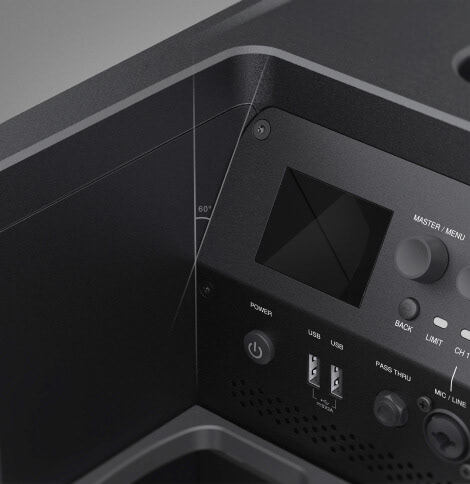Small-stage performers and buskers require a sound system that’s lightweight and easy to take on the go while still providing high-quality audio. The JBL EON ONE MK2 has an ergonomic handle design which Huemen optimized to make travel and setup seamless. We created a smart locking system in the back of the product chassis where the array column can be separated and stored conveniently during transit. The column is held in place securely with a unique double-injection latching mechanism to prevent unwanted vibrations.
The challenge
With the rise of remote audio management needs, JBL Professional aimed to enhance its existing Pro Connect app to provide better control, improved accessibility, and a more intuitive user interface. The goal was to redesign the app to accommodate new features, improve usability, and ensure consistency across various devices.


Research and Discovery
User Research:
Stakeholder Interviews:
Conducted interviews with JBL product managers, audio engineers, and marketing teams to understand the app's core functionalities and target audience.
Conducted interviews with JBL product managers, audio engineers, and marketing teams to understand the app's core functionalities and target audience.
User Surveys:
Deployed surveys to existing users to gather feedback on the current version, focusing on pain points, frequently used features, and desired improvements.
Deployed surveys to existing users to gather feedback on the current version, focusing on pain points, frequently used features, and desired improvements.
Competitive Analysis:
Analyzed competing audio control apps to identify industry standards, innovative features, and potential gaps that JBL Pro Connect v2 could address.
Analyzed competing audio control apps to identify industry standards, innovative features, and potential gaps that JBL Pro Connect v2 could address.
Key Findings:
Complexity:
Users found the previous version challenging due to its complex navigation and overcrowded interface.
Users found the previous version challenging due to its complex navigation and overcrowded interface.
Feature Requests:
Many users requested more streamlined access to key features such as EQ adjustments, presets, and multi-device management.
Many users requested more streamlined access to key features such as EQ adjustments, presets, and multi-device management.
Cross-Platform Consistency:
Users expressed frustration with inconsistent experiences across mobile, tablet, and handheld devices.
Users expressed frustration with inconsistent experiences across mobile, tablet, and handheld devices.
Design Objectives
Simplify Navigation:
Develop a more intuitive navigation system that reduces the learning curve and allows quick access to essential features.
Enhance Visual Hierarchy:
Improve the visual hierarchy to ensure that the most critical controls are easily accessible and understandable.
Improve the visual hierarchy to ensure that the most critical controls are easily accessible and understandable.
Responsive Design: Ensure a seamless experience across all devices by designing a responsive and adaptive UI.
User-Centric Features:
Introduce features that align with users' needs, such as customizable presets, real-time feedback, and remote monitoring capabilities.
Introduce features that align with users' needs, such as customizable presets, real-time feedback, and remote monitoring capabilities.
Design Process
Solutions
Multi-Device Compatibility:
- Ensuring a consistent user experience across mobile, tablet, and handheld devices with varying screen sizes and interaction patterns.
- Implemented a responsive design approach with adaptive layouts that adjusted based on screen size and device type. Additionally, leveraged platform-specific design patterns to enhance familiarity and ease of use.
Complex Audio Features:
- Balancing the need for advanced audio control features with the requirement for an intuitive and accessible interface.
- Designed a layered interface where basic controls were easily accessible, and advanced features were tucked into expandable sections. This approach catered to both novice users and professional audio engineers.
Real-Time Feedback:
- Providing users with real-time feedback on their audio adjustments without causing performance issues or delays.
- Collaborated closely with the development team to optimize data processing and ensure that the app delivered real-time updates efficiently. Introduced visual indicators and haptic feedback to enhance the user experience.
Outcomes and Impact
1. Increased User Engagement:
Post-launch analytics showed a significant increase in user engagement, with more users accessing and utilizing advanced features than in the previous version.
2. Positive User Feedback:
User satisfaction surveys indicated a substantial improvement in the overall user experience, particularly in navigation simplicity and visual appeal.
3. Cross-Platform Consistency:
The responsive design approach resulted in consistent user experiences across all platforms, reducing the frustration previously reported by users.
4. Market Differentiation:
The app's redesign positioned JBL Pro Connect v2 as a leader in the market, with features and usability that outperformed competitors' offerings.
Conclusion
Working on the JBL Pro Connect App v2 was a rewarding experience that involved tackling complex design challenges to deliver a product that met both user needs and business goals. By focusing on user-centered design principles, I was able to contribute to an app that not only enhanced the JBL product ecosystem but also delivered a superior user experience across multiple devices.

